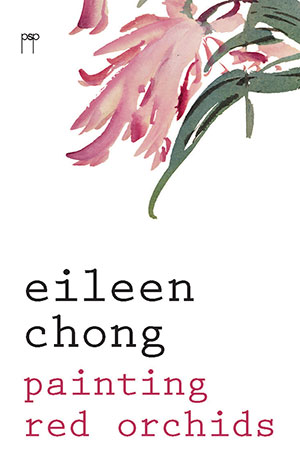
Painting Red Orchids by Eileen Chong
Pitt Street Poetry, 2016
In his short story ‘A Little Ramble’, champion of the anti-heroic Robert Walser says, ‘We don’t need to see anything out of the ordinary. We already see so much’. In her third collection, Painting Red Orchids, Singaporean Australian Eileen Chong testifies to ordinary experience as the sensory and emotional kaleidoscope of the individual. These are the lyrical portraits of a perpetual itinerant, her introverted recordings of private joys, loneliness and fascination with solitary journeying through a rich inner world. Sensorial and intellectual curiosity abound in her peripatetic wanderings any place and any time: Sydney’s Chinatown, Parramatta, the seaside, the Australian goldfields, Tang dynasty China, a friend’s kitchen.
The eponymous ‘Painting Red Orchids’ opens the collection and is one of its highlights. Chong explores the Qing artist Huang Shen’s painting, ‘Red Orchids’, which in traditional ink wash painting style captures the life and energy of the subject rather than its literal likeness. Chong cleverly plays on this aesthetic tradition by textually re-enacting Huang Shen’s process of creation, and in so doing, the life and becoming of the red orchids:
One stroke, one breath: leaves give way to blossom. More water—rain and cloud above the trees. Cochineal paste, jade seal—red orchids bloom on white.
Similar to the closely related forms of traditional Chinese calligraphy and painting where text and image share similar techniques and appear together in dialogue, here poetry converges thematically with visual art. But Chong takes this further, occupying the position of Huang Shen with first-person narration, examining the provenance of the materials she / ‘he’ paints with:
…This one, an eyelash from a leopard. The inkstone was my father’s: slate quarried from the lake where my great-grandfather drowned himself one spring night. I scoop well-water
The unrushed pace of these lines show the narrator, with Buddhistic mindfulness, recounting the life of each material that makes the painting and constitutes its life and energy. These items are material testaments to the trauma of past lives. These lines, some of the most accomplished in Chong’s collection, provide a kind of technical and thematic sleight of hand. Upon closer reading, the ekphrastic poem reveals its true complexity: a tapestried introduction for the mental and emotional landscape of the collection, a deft expression of art’s many lives. Chong’s art soars when she draws on classical Chinese motifs and inhabits myths (‘Magnolia’; ‘Seven in the Bamboo’). Through the high drama of history and legend, played out in anachronistic time and embodied by contemporary selves, Chong skilfully enacts the indelible mark of heritage on the imagination.
Conversely, a kind of self-conscious, ‘East-meets-West’ cultural exchange that the poet attempts, often through food imagery, is less successful. Awkward and clichéd, the narrator in ‘Sun Ming Restaurant, Parramatta’ ponders:
… How did we find each other in this faceless city, on this wide continent, coming as we did from worlds so far apart? […] … We share hot tea, spinach with three kinds of egg, and learn a new rhythm.
Similarly in ‘Xiao Long Bao (Little Dragon Dumplings)’, the narrator conflates food appreciation with cultural connection:
I still remember the look on your face when you ate your first little dragon dumpling. Sudden understanding.
From ‘A Winter’s Night’:
This, here, made from my hands, his memories—we consume spoon after spoon of history and desire and laugh about the future.
Chong’s strong craft and technique are at these points stifled by the clumsy and superficial treatment of multiculturalism, particularly in her depiction of exoticised cuisine and food rituals as sensual cross-cultural exchanges – usually within the bounds of a romantic relationship. This is accompanied often by the overuse of the contrived word ‘lover’ in such contexts: ‘My lover takes me to his favourite Chinese/restaurant’ or ‘My lover holds my hand and walks me through/an unfamiliar cityscape.’ (‘Sun Ming Restaurant, Parramatta’); ‘I am on the telephone/with my lover’ (‘Resonance’).
Nevertheless, it is with touching everydayness that Chong expresses the emotional state of an itinerant; her naturally rhythmic, prose-like descriptions intimate and immortalise the ephemeral, contingent and elusive. Flights of fancy, memory, nostalgia, dreams and desire are familiar secrets for both poet and reader. In ‘Taboo’, the seemingly blameless narrator offers a heartbreaking, imploring defence to an unknown crime,
I swear I didn’t. I never could. How much do I want? All the years, and none.
Sounding the death knell of a doomed relationship, these simple, sparse lines display an aching silence, conveying the unspeakable pain of love’s ending as it occurs. Prefiguring the death of a love that will never be, Chong is a clairvoyant of loss, imbuing her lines with pre-emptive, nihilistic disavowal.
What I think is the compelling soul of these poems – more than their subject matter (food, love, solitude, travel or dreams), or their technical artistry – is their unmaskable shadow of trauma, and the past lives that occasioned this work. For example, Chong writes, ‘On good days / there is chocolate. There is always a cup of tea. I don’t/think about pain, or loss, or the past, although they are there’ (‘Seven in the Bamboo’). She hints at the toil of survival with a poignantly innocuous line, ‘The trick / is to keep swimming, to keep taking in air’ (‘Trick’). Upon reading these poems, one after another, their accumulative effect is one of oblique sadness amidst joyful discovery, a sense of a rebirth destined to be haunted by the weight of past lives. It is an evocation as powerful and moving as any great literature I know. A self-described ‘poet of small things’, Chong’s intimate poems of minute complexities see so much in the ordinary and inspire a gladness of solitude.









